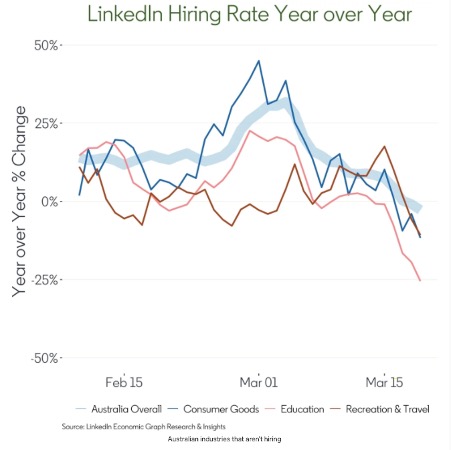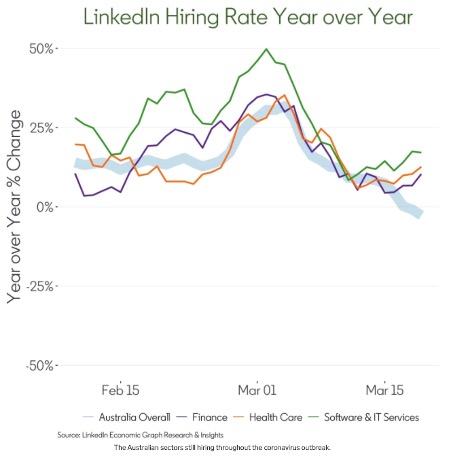These are the industries still hiring in Australia, as the coronavirus sends job growth into negative territory

People queuing up at Centrelink. Pic: Getty Images
It’s no secret that hundreds of thousands of Australians have suddenly found themselves unemployed.
The spread of COVID-19 is not only forecast to launch national unemployment into double digits for the first time in nearly 30 years, but has also led firms to freeze hiring and even withdraw advertised jobs.
“LinkedIn’s hiring data shows a gradual decline in year-on-year hiring growth in Australia, with a sharp drop towards the end of last week,” Adam Gregory, a senior director at LinkedIn, told Business Insider Australia in a statement.
“We anticipate this decline in hiring growth to deepen in the coming weeks.”
Overall, the hiring rate which had stalled at a worrying 0 per cent in recent weeks, plunged into negative territory, falling to -2.8 per cent last week, according to the platform’s jobs data.
With the likes of Qantas and Virgin Australia largely going into hibernation for at least two months, and people choosing to cancel trips and stay home amid the global pandemic, the worst-hit industries are obvious.

“The travel bans and shutdown restrictions on social gatherings have had a significant impact on jobs and hiring intentions in certain industry sectors such as aviation, travel and hospitality. Such restrictions have also significantly impacted service sectors such as tourism, retail and food and beverage,” Gregory said.
“The education sector has also slowed down, likely due to travel bans affecting the return of foreign students.”
In fact, the education sector appears to have been the canary in the coal mine. Australian universities were some of the first organisations to be hit as many of the international students on which they rely – many of whom are from China – were unable to resume their studies.
The development no doubt helped cannonball the $31 billion-plus export market, and slash recruitment by 25.6 per cent, making it the worst-hit sector in the country so far.
However, while the Australian government wrestles with how to both keep businesses and people alive, there are some industries that appear to be bucking the downturn so far.

“In the case of the healthcare industry, there is likely a greater demand for healthcare professionals during this period, [while] the software and finance industries are more likely to have more jobs that can work remotely,” Gregory said.
The sudden rush of businesses of all shapes and sizes to get their employees working from home however has seen software and IT jobs enjoy the biggest recruitment surge.
Hiring has grown by 17.3 per cent, even outpacing healthcare, at 12.6 per cent. While not included in the data set, an unanticipated spike in demand has also spurred separate recruitment drives by both Coles and Woolworths, with both supermarkets picking up some of the slack in the labour force.
Interestingly, Australia’s overall recruitment was far quicker to react to the coronavirus pandemic than other countries. China, the UK, and the US all only saw real downwards movement in recruitment during the month of March, while Australia’s plummeted in mid-February, according to the LinkedIn data.
Like the length of the crisis, how those industries continue to fare as the federal government prepares Australian businesses for a new “hibernation” phase is still largely unknown.
This article first appeared on Business Insider Australia, Australia’s most popular business news website. Read the original article. Follow Business Insider on Facebook or Twitter.
Related Topics
UNLOCK INSIGHTS
Discover the untold stories of emerging ASX stocks.
Daily news and expert analysis, it's free to subscribe.
By proceeding, you confirm you understand that we handle personal information in accordance with our Privacy Policy.








